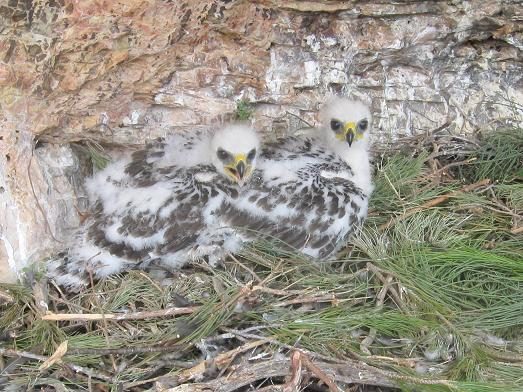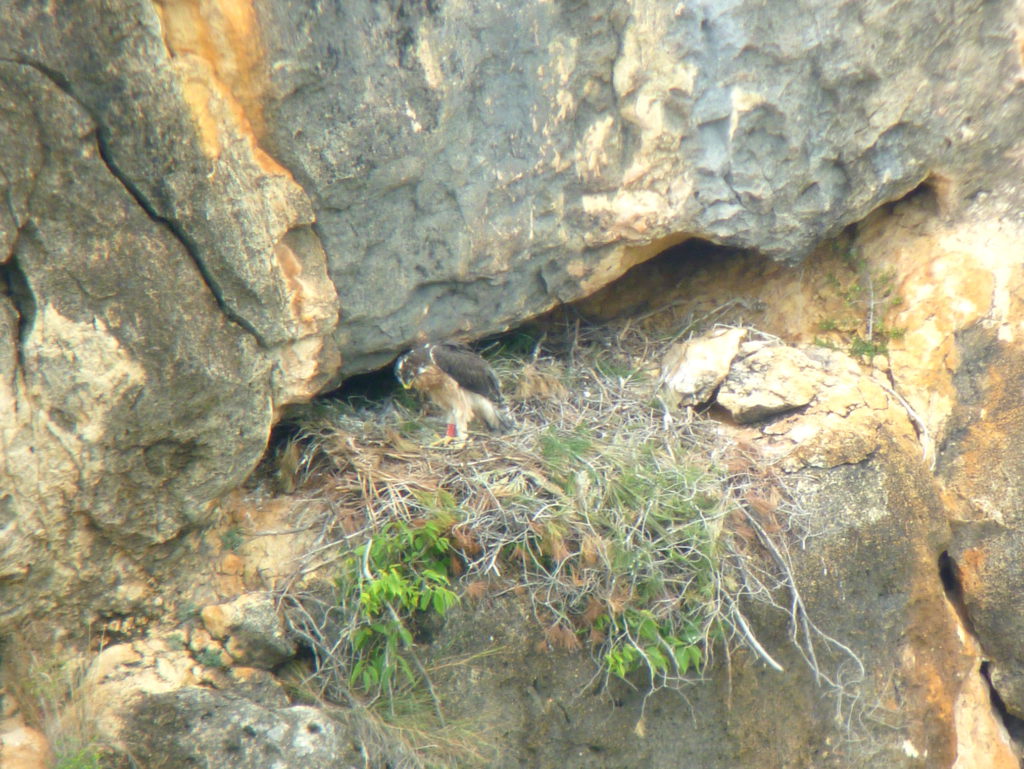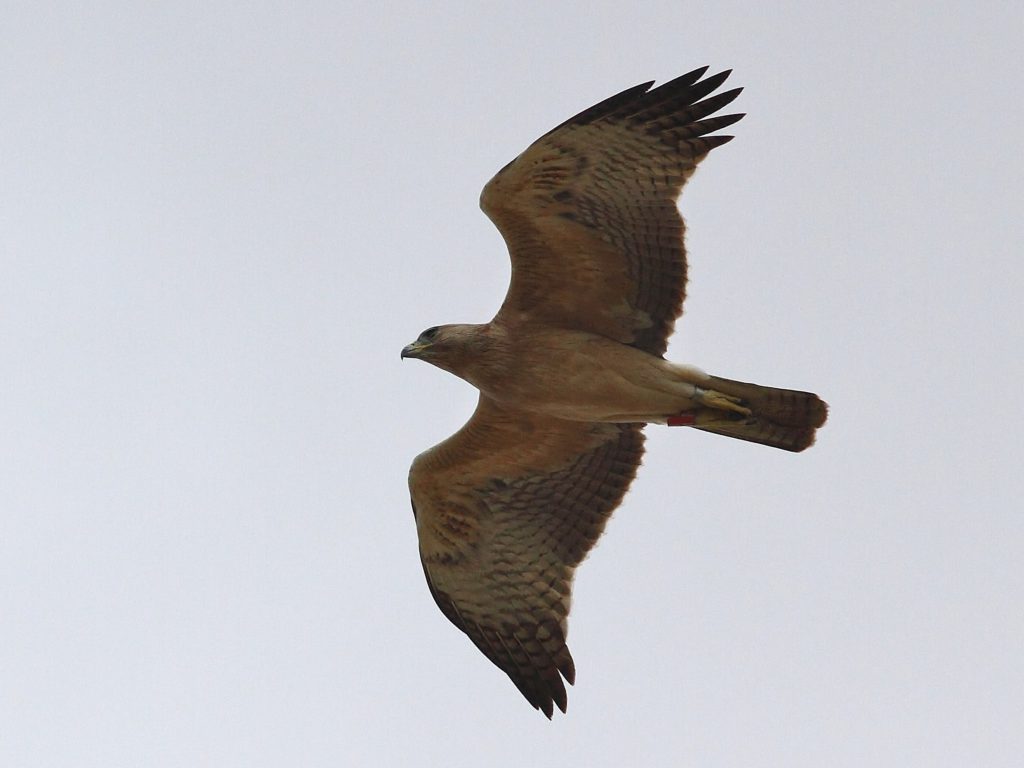Bonelli’s eagle
When we started studying Bonelli’s eagle during the 70’s, there was practically no scientific information about this species in Catalonia, even of those basic aspects of the biology and ecology of a species such as its reproductive biology and behaviour. The little information available came from anonymous people from rural areas, such as hunters, farmers or shepherds. Outside Catalonia there were pioneering studies in Provence and Languedoc, and some other in Andalusia and Castile. Given this lack of scientific information, during the 70’s we began to undertake intensive observations in Bonelli’s eagle territories aimed at knowing its phenology, the behaviour of the adults during the reproductive period and factors determining the reproductive success. The annual monitoring of the Catalan population of Bonelli’s eagle conducted since 1980 has been a regular and updated source of information on these issues. Thanks to this, we know that eagles breeding cycle begins in winter, with the nuptial flight and the reconstruction of the nests. The laying, usually 2 eggs, happens normally in February. The incubation lasts about 40 days and is mostly done by the female, whereas the male hunts and watches over the territory. The chicks are born on the second fortnight of March. In the first weeks of life, they are covered and fed by the female that hardly ever leaves them alone in the nest. We also know that non-adult eagles produce fewer chicks than adults, so the breeding success varies with parents age.
To study juvenile emancipation and their behaviour during this period, in 1987 we followed the movements of 5 individuals wing-tagged and banded in the nest, four of which were also radio-tagged. This allowed us to know that juveniles left the nests 60-70 days after hatching. At first, they cannot fly, and they spend the whole day walking through the vegetation and rocky places, where adults can watch over them and bring them preys. From the third month adults stop feeding the juveniles and abandon them gradually. This is the moment when they decide to leave the parents territory and become definitively emancipated.
Finally, to provide a quantitative method for ageing and sexing Bonelli’s eagle chicks, we compiled information on biometry measures and plumage patterns of 175 individuals captured during 1999-2002 in several populations of the Iberian Peninsula and France. Results showed that it is possible to determine age and sex in base of both biometric measures and plumage patterns. This is a very useful information for those monitoring tasks to obtain the demographic parameters for the species, since the right identification of territorial individuals allows us to indirectly estimate survival rates for territorial birds through the turnover rate (opposite to survival rate), which is computed for each territory as the total number of birds that either disappear from that territory from one year to the next or are replaced by a bird of another age, in relation to the total number of individuals and years considered.
These studies were carried out thanks to the support from several administrations, organisations and companies. Among them, Miguel Torres S. A., Diputació de Barcelona, and the Ministerio de Agricultura, Alimentación y Medio Ambiente.
Related publications
A34.- GARCÍA, V., MORENO-OPO, R. & TINTÓ, A. 2013. Sex Differentiation of Bonelli’s Eagle Aquila fasciata in Western Europe using Morphometrics and Plumage Colour Patterns. Ardeola, 60 (2): 261-277. doi:10.13157/arla.60.2.2013.261 pdf
A14.- REAL, J., MAÑOSA, S. & CODINA, J. 1998. Post-nestling dependence period in the Bonelli’s eagle Hieraaetus fasciatus. Ornis Fennica, 75:129-137. pdf
A9.- MAÑOSA, S., REAL, J. & CODINA, J. 1995. Age estimation and growth patterns in nestlings Bonelli’s eagles. Journal of Raptor Research, 29 (4): 273-275. pdf
A5.- REAL, J. 1983. Dades sobre la biologia de l’àliga cuabarrada (Hieraaetus fasciatus Viell.) a la Serralada Pre-litoral Catalana. Butll. Inst. Cat. Hist. Nat., 49 (Sec. Zool. 5): 127-141. pdf
B26.- ROLLAN, À., HERNÁNDEZ-MATÍAS, A. & REAL, J. 2016. Guidelines for the conservation of Bonelli’s eagle populations. Universitat de Barcelona. Barcelona. http://hdl.handle.net/2445/69446 pdf
D2.- REAL, J. 1991. L’àliga perdiguera Hieraaetus fasciatus a Catalunya: status, ecologia tròfica, biologia reproductora i demografia. Tesi doctoral. Universitat de Barcelona.
D1.- REAL, J. 1982. Contribució al coneixement de la biologia i distribució de l’àliga cuabarrada Hieraaetus fasciatus (Vieillot, 1822) a la serralada Pre-litoral Catalana (Falconiformes, Accipitridae). Tesi de Llicenciatura. U.A.B.



